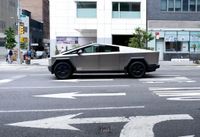It’s been a wild summer for electric vehicles (EVs) across North America, with Tesla making headlines for both a sudden sales surge and mounting challenges, while automakers and governments grapple with shifting policies and consumer sentiment. At the heart of the story: the impending expiration of the U.S. federal $7,500 EV tax credit, a cornerstone of the American electric car boom, and the reverberations as the market braces for a new era.
In mid-August 2025, Tesla experienced an unexpected spike in Model Y orders, a phenomenon that, according to Madrid Barcelona, wasn’t the result of flashy promotions or technical upgrades. Instead, it was the simple, urgent reality that the $7,500 tax credit is about to vanish, making this quarter the last chance for buyers to benefit. The impact was immediate: delivery times for the Model Y stretched from a typical 1-3 weeks to 4-6 weeks as inventories struggled to keep up with demand. “Those who wanted to take advantage of the credit are already buying their Teslas,” the publication noted, underscoring just how pivotal government incentives have been in driving EV adoption.
But this sales spike may be fleeting. Economists call it a "dead cat bounce"—a sharp but temporary rebound before a potential decline. Once the tax credit expires in October, the price of a Tesla will effectively jump by $7,500, posing a daunting question for would-be buyers: is an unsubsidized Tesla still worth it? Elon Musk himself has warned that the coming quarters could be rough, citing both the challenges of autonomous driving and growing consumer skepticism. Indeed, 2025 has been a tough year for Tesla, with controversies swirling around Musk and persistent concerns about the company’s self-driving technology eroding trust among buyers.
The competitive landscape is only getting tougher. Brands like Hyundai, BYD, and Volkswagen are rolling out more affordable electric models, offering good technology and attractive features for the average consumer. Without the cushion of federal subsidies, Tesla will have to compete on price and value alone—a prospect that could slow its sales momentum. As Madrid Barcelona points out, Chinese manufacturers are now seen as viable alternatives, especially for buyers prioritizing affordability and reliability.
Meanwhile, Tesla’s strategy with its flagship Cybertruck has shifted gears. On August 22, 2025, Tesla quietly raised the price of its high-end Cybertruck model, the Cyberbeast, by $15,000, bringing the price tag to a hefty $114,990. According to Stocktwits, this increase comes with the addition of a Luxe Package, bundling supervised full self-driving, free lifetime supercharging, four-year premium service, and free lifetime premium connectivity. The Cyberbeast boasts a range of 366 miles and a 5-star safety rating, but the price hike means it’s now out of reach for most buyers—and, crucially, ineligible for the soon-to-expire $7,500 tax credit, which is capped at $80,000 for pickup trucks.
Other Cybertruck variants remain unchanged in price, but the market for these futuristic pickups is more muted than initial hype suggested. Despite over a million reservations since late 2023, Tesla has sold only about 52,000 Cybertrucks in the U.S. so far, according to CNBC. The company’s overall sales have also slumped: Tesla delivered 384,122 vehicles in the second quarter of 2025, a 13.5% year-over-year decline and the second straight quarter of falling deliveries. As Stocktwits reports, retail sentiment on the company is "bearish," and the future looks even more uncertain as the Trump administration moves to end the federal EV tax credit in October.
This policy shift is sending shockwaves far beyond Tesla. In Canada, automakers and governments are doubling down on long-term EV strategies, even as U.S. incentives disappear. Earlier this month, Volkswagen-owned PowerCo SE began hiring for hundreds of positions at its new battery plant in St. Thomas, Ontario, with production slated for 2027. Two major Asian auto parts suppliers are expanding the EV supply chain in Windsor, and Ford just announced a $5 billion plan to overhaul its assembly process to make EVs more affordable. As Clean Energy Canada’s Joanna Kyriazis and Evan Pivnick wrote in Castanet, these moves are “long-term investments that need to be evaluated with a long-term lens,” echoing Hyundai Canada’s Steve Flamand: “Carmakers think in decades, not months.”
British Columbia, for its part, is holding firm on its ambitious EV mandate. Since 2019, the province’s policy requiring carmakers to supply more EVs has driven zero-emission vehicle sales from just 4.1% of new cars in 2018 to 22.4% in 2024, with nearly 200,000 electric cars now on B.C. roads. The result? A wider selection of models, increased affordability—used EVs with over 400 kilometers of range now sell for around $20,000—and high consumer interest. A 2025 Abacus Data survey found that nearly 70% of Metro Vancouver residents are inclined to make their next car an EV, including 82% of those aged 18-29. Even after the province paused its popular rebate earlier this year, support for EVs remains robust.
Still, British Columbia faces its own pressures. Some auto groups are lobbying to weaken the province’s EV sales regulation, citing the end of U.S. tax credits as a reason to scale back. But as Clean Energy Canada’s experts argue, “the B.C. government should channel this same mantra” of thinking long-term, rather than reacting to short-term political winds. They suggest tweaks—like awarding extra credits for discounted EVs—to keep the policy effective and affordable, even as global trade tensions and tariff wars loom.
As the U.S. prepares to phase out its tax credit and Tesla’s sales rollercoaster continues, the broader EV market is at a crossroads. The cost-saving, convenience, and climate benefits of electric vehicles are clearer than ever, but the path ahead will be shaped by shifting policies, evolving consumer attitudes, and the willingness of automakers and governments to play the long game. For now, the race to electrify North America’s roads is far from over—and the stakes couldn’t be higher.
With incentives waning and competition intensifying, Tesla and its rivals face a defining moment. The choices made in the coming months will determine not just who leads the EV market, but how quickly—and affordably—the world transitions to cleaner transportation.




